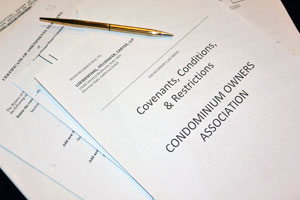David Loewenthal will be participating as a speaker at the CACM Southern California Law Seminar – January 21, 2011. For information visit:
http://www.cacm.org/southerncalawseminar.aspx
AB2016 (Torres) Common interest developments: requests for notices of default: An act to amend Section 2924b of the Civil Code, relating to common interest developments.
Last date of legislative activity: 08/13/2010
Last Action: Chaptered by Secretary of State – Chapter 133, Statutes of 2010.
Description: The Davis-Stirling Common Interest Development Act provides for the creation and regulation of common interest developments. Under existing law, a common interest development is managed by an association pursuant to the provisions of the governing documents of the development. Existing law requires a trustee or mortgagee to record a notice of default and to post and publish a notice of sale prior to selling real property at a foreclosure sale. Existing law allows an association, with respect to separate interests governed by the association, to record a single request that a mortgagee, trustee, or other person authorized to record a notice of default regarding any of those separate interests mail to the association a copy of any trustee’s deed upon sale concerning a separate interest, as specified.
This bill would clarify that a request by an association for notification of trustee’s deed of sale does not, for purposes of a specified statute, constitute a document that either effects or evidences a transfer or encumbrance of an interest in real property or that releases or terminates any interest, right, or encumbrance of an interest in real property.
IMPACT TO HOA’s: Beginning in January 2011, the enactment of AB2016 will enable an Association to record one (1) blanket request for a copy of a trustee’s deed for the whole development by including the assessor’s parcel number and/or the legal descriptions for all separate units/homes for which a lender may hold ownership through foreclosure or other processes. Prior to the passage of this legislation; separate requests for each unit/home were required. Once the trustee’s deed is recorded; a lender must send a copy of the deed to the Association within 15 business days following the recording date for the trustee’s deed for each unit/home. It is very important for Associations to remember that requests for copy of a trustee’s deed upon sale must be recorded before a lender’s recording of a notice to default under the deed of trust.
REVIEW OF SIGNIFICANT APPELLATE COURT DECISIONS FROM 2010
1. Affan et al. v. Portofino Cove Homeowners Association (Oct. 2010) (CA. Dist. 7 CT. APP, Div. 3)
Application of LAMDEN judicial deference rule:
This recently decided case provides some significant depth in application of the judicial deference rule stated in the Supreme Court’s decision in Lamden v. La Jolla Shores Clubdominium Homeowners Association (1999) 21 Cal. 4th 249. In Lamden, the Supreme Court, using the business judgment rule as its basis, ruled that California courts would defer to the judgment of Boards of Association’s relative to the means and methods of ordinary maintenance that the Association was obligated to perform. For this judicial deference to be applied, the Association has the burden of demonstrating that a maintenance decision was made upon reasonable investigation, in good faith and with regard for the best interests of the community association and its members.
In Affan, the Association had for a period of at least five years failed to investigate the cause of repetitive sewage backups from the common area waste lines in this condominium project and had failed to implement any prophylactic maintenance program to address the sewage back ups. The Association’s approach was to have the drain line snaked whenever a sewage back up was reported. After five years of backups, in May, 2005, the Association enters into a five year maintenance contract with Rescue Rooter to perform “routine maintenance” to the waste lines. On May 3, 2005, Rescue Rooter hydro-jetted the main waste lines in the building. On May 14, 2005, the Affan’s experienced a major sewage backup in their unit with waste overflowing onto the unit’s floors, causing significant damage. At trial, a plumbing expert for the Affan’s testified that the repeated back ups were the result of ten years or more of no maintenance being done on the waste lines and that Rescue Rooter had not used the proper techniques in May 2005 to clear the lines.
The trial court applied the judicial deference rule from Lamden and found that the Association was not negligent and had not breached the CCRs relative to the maintenance of the waste lines and resulting damage to the Affan’s unit. The appellate court reversed that decision, finding that at trial, the Association had not carried its affirmative burden of demonstrating that it was entitled to judicial deference under Lamden relative to the waste line maintenance. The Court found that the Association had not demonstrated that it had performed any investigation on which it based a good faith decision to maintain the waste lines as it had, and as such the Board’s decision to “do nothing” for many years was not entitled to deference.
The decision clarifies that the Association has the burden of introducing evidence of its investigation of the various options regarding maintenance and that the deference is not automatic. In the absence of an investigation of the options, the Court found that there was no possibility of a “good faith decision concerning maintenance” to give deference to. The decision also makes clear that a “decision to do nothing” could receive deference under Lamden provided that the Board’s investigation of the problem and the options of dealing with the problem had been diligently considered as the basis for the decision to not act, and that decision was made with the best interests of the Association and its members in mind.
Board’s and management should keep in mind that to insulate the Association, board and management from claims of negligence and breach, it should engage and rely upon opinions of experts, be they contractors, engineers or legal counsel, in making decisions concerning means and methods of maintenance and repairs. Reliance upon professionals is not mandatory for application of the Judicial Deference rule in Lamden, but it is one of the prerequisites under the related business judgment rule and provides a strong basis that the Association has performed its due diligence.
2. Clear Lake Riviera Community Association v. Cramer (2010) 182 Cal. App. 4th 459.
Hardship Doctrine applied to test whether a non-compliant structure must be removed; How Association’s can prove enforceability of Architectural guidelines.
This 2010 case was an enforcement action by an Association against a lot owner who built a structure which exceeded a long-enforced 17 foot height restriction (in place prior to the requirements of Civil Code Section 1357.100) and which did not conform to the plans approved during the architectural review process. In approving plans submitted by the Owner, the committee stamped on each page that the height was not to exceed 17 feet and the Owner was informed several times of the height restriction. The Owner built a house which exceeded 17 feet in height and which exceeded by 9 feet what was represented in the approved plans.
The Association sought an injunction to compel the Owner to comply with the height restrictions and the approved plans. The Owner’s defenses were that it would be too great a hardship to require the structure to be modified and that the Association had not demonstrated that the height restriction had been properly adopted under California law.
The trial court found that the Association did not have to demonstrate through direct evidence (testimony or documents which prove how the restriction was adopted) but could use circumstantial evidence that the restriction had been in place and enforced for years to prove proper adoption. The trial court also found that the restrictions did not have to comply with Civil Code Section 1357.100 because the guidelines had been adopted prior to that statute going into effect. The trial court also found in favor of the Association and issued a mandatory injunction compelling the Owner to modify his home.
The appellate court held that the “hardship doctrine” must be applied in determining whether to uphold the trial court decision ordering the Owner to comply with the guidelines. The appellate court analogized to situations where a property owner seeks to have an encroaching structure removed from his/her property. In that scenario, the three factors are:
1. Was the defendant (encroacher) innocent? In other words, was the encroaching Owner negligent or willful in causing the encroachment?
2. Would the rights of the public be harmed by requiring the removal the encroachment?
3. The hardship to defendant would be greatly disproportionate to the hardship caused to plaintiff by the continued encroachment.
The trial and appellate courts both concluded that the Owner was not innocent and under the best light, were negligent. The appellate court also found that the Association’s ability to enforce the governing documents consistently would be impaired significantly if an owner could argue it would be unreasonably expensive to comply after the structure was built. This is part of the ever-growing trend where it is easier to ask for foregiveness than to seek permission.
This case provides some valuable insight to counsel and Board’s towards evaluating whether an injunctive relief action should be pursued to obtain compliance with architectural restrictions. It also highlights the importance of distributing guidelines to members and in clearly documenting what the architectural committee is considering, what it is relying on making a decision and what the basis is for the decision. Clear documentation of the review process is essential to having courts enforce the guidelines and approvals made through the review process. It also suggests that it would not be a bad idea for the Board of Directors to annually ratify the adoption of all rules and regulations and guidelines when no changes have occurred and make that disclosure along with the rest of the annual disclosures, to avoid the evidentiary issue discussed in the case.
3. Pinnacle Museum Tower Association v. Pinnacle Market Development (2010) 187 Cal. App. 4th 24 and Treo@Kettner Homeowners Association v. Superior Court (2008) 166 Cal. App. 1055.
Enforcement of Developer Imposed Dispute Resolution Limitations in CCRs
These two cases, one from this year and the other from 2008, are closely related to one another as they represent the recent trend in appellate decisions which do not allow developers of projects who create the original governing documents to “stack the deck” in the developer’s favor while eliminating fundamental constitutional rights of Association’s concerning what forum to have construction defect claims of Association’s resolved.
Virtually all modern associations are established as non-profit corporations, which under California and Federal law, are considered as “natural persons” that are entitled to the same legal rights to use the judicial system as individuals. Both California and Federal Courts have long recognized the rights of individuals and corporations to bargain away the right to sue in court or have a matter decided by a jury trial.
The substance of both these cases is that in the context of the limiting the rights of Association’s to pursue claims against the developer, the CCRs do not constitute contracts which bind the Association because there has been no negotiation between the Association and the Developer which would justify such limitations. The courts recognize that when the CCRs were imposed by the Developer, the Developer was also the creator and controller of the corporate entity that is the Association. These decisions both reference that there are no California appellate decisions which treat CCRs as a contract, except as between the Association and its members. This was particularly true when the CCRs provided for a complete waiver of the constitution right of the Association to have a jury trial in its claims against the Developer.
4. Wolf v. CDS Devco (2010) 185 Cal. App. 4th 903.
Director’s absolute right to inspect Association records stops when term ends.
California Corporations Code Section 8334 gives sitting directors of Association’s the absolute right to inspect and copy any and all records of the Association. This case clarifies that this right terminates when the term of the director expires or the director is not re-elected by the members.
In this case, Wolf was a long-time director of a corporation whose filed a lawsuit to compel his right to inspect corporate records. This case did not involve a homeowners association, but is clearly applicable by analogy. Wolf sought re-election at the annual meeting of shareholders shortly after commencing his lawsuit. When he was not re-elected, he amended his lawsuit to clarify that he was no longer a director. The trial court then dismissed the complaint on the basis that he no longer had standing to assert the right to inspect corporate records. In upholding this decision, the appellate court relied on a 1995 HOA case (Chantiles v. Lake Forest II Master HOA) which held that a former director could not use his inspection rights under Section 8334 to inspect ballots in an election challenge, based on lack of standing.
5. Worldmark, The Club v. Wyndham Resort, Robin Miller (2010) 187 Cal. App. 1017
Email addresses are considered “addresses” that must be produced as part of the membership roster under Corporations Code Section 8330.
California Corporations Code Section 8330 (somewhat in parallel with Civil Code Section 1365.2) provides that Associations are obligated to provide members with copies of the membership roster with the addresses of members, upon a written request for a reasonable purpose.
This case stands for the proposition that if an Association compiles email addresses of its members and those members do not “opt out” pursuant to Civil Code Section 1365.2 as to those email addresses, the Association is obligated to provide a member both “addresses,” including email addresses, upon the members stating a proper purpose for communicating to or with the membership. A proper purpose simply means any purpose related to the member’s interest in the development, even if that purpose may be to attempt to generate interest in a lawsuit against the Association.
The novel facts of this case undoubtedly impacted this decision, as the Court recognized that the cost of contacting the 260,000 by mail would essentially prevent any individual from exercising his/her legitimate rights of membership. The facts suggested that Wyndham was making it very difficult for the members, who wanted to propose a change of the Bylaws of the corporation.
Ultimately, the court ruled that the use of “addresses” in Section 8330, in light of the rapid acceptance of electronic communications as a legitimate and reliable alternative to regular mail, was reasonable in light of the growing trend in statutes to treat email addresses and postal addresses with only minimal distinction.
The lesson to be learned from this case is that Board’s and management should develop opt out plans for member participation relative to disclosure of email addresses, or tell members that email addresses will be supplied as part of the membership roster. Many members may not want their email addresses widely disseminated and they should have the opportunity to protect their privacy.


